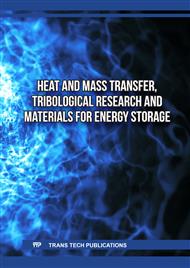[1]
Chen H, Zhao L, Lu S, Lin Z, Wen T, Chen Z. Progress and perspective of ultra-high-strength martensitic steels for automobile. Metals. 2022 Dec 19; 12 (12): 2184
DOI: 10.3390/met12122184
Google Scholar
[2]
Tikhomirov D, Rietman B, Kose K, Makkink M. Computing welding distortion: comparison of different industrially applicable methods. Advanced materials research. 2005 May 1;6:195-202
DOI: 10.4028/www.scientific.net/AMR.6-8.195
Google Scholar
[3]
Liu Y, Liu JX, Yan SY, Wang ZM, Zhang B. Deformation Analysis for Welding Assembly Processes of Automobile Panels. Advanced Materials Research. 2010 Jun 30;118:70-4
DOI: 10.1002/qre.1550
Google Scholar
[4]
Huanga H, Maa N, Yuanb S, Murakawaa H. Analysis of Welding Deformation and Residual Stress in Automotive Engine Cradle by i-ISM and DMRM. Ratio.;1:2.
Google Scholar
[5]
Weglowski, M. St., Zeman, M., & Lomozik, M.: Physical simulation of weldability of Weldox 1300 steel. Material Science Forum, 762, 2013. p.551–555
DOI: 10.4028/www.scientific.net/MSF.762.551
Google Scholar
[6]
Tümer, M., Pixner, F., & Enzinger, N.: Residual stresses, microstructure, and mechanical properties of electron beam welded thick S1100 steel. Journal of Materials Engineering and Performance, 31, 2021. p.2136–2146
DOI: 10.1007/s11665-021-06348-1
Google Scholar
[7]
Amraei M, Afkhami S, Javaheri V, Larkiola J, Skriko T, Björk: T, Zhao XL: Mechanical properties and microstructural evaluation of the heat-affected zone in ultra-high strength steels. Thin-Walled Structures 157:107072, 2020
DOI: 10.1016/j.tws.2020.107072
Google Scholar
[8]
Kovács, J., Lukács, J.: Influence of Filler Metals on Microstructure and Mechanical Properties of Gas Metal Arc Welded High Strength Steel, Lecture Notes in Mechanical Engineering, Vehicle and Automotive Engineering 4, 2022 pp.995-1005
DOI: 10.1007/978-3-031-15211-5_83
Google Scholar
[9]
Sisodia, R. P.S., Gigli, Lara ; Plaisier, Jasper ; Mertinger, V., Weglowski, M., Sliwinski, P.: Synchrotron diffraction residual stresses studies of electron beam welded high strength structural steels, Journal of Materials Research and Technology, 30, 2024. pp.6291-6300
DOI: 10.1016/j.jmrt.2024.04.240
Google Scholar
[10]
Zuidema, B. (2015, December 22). Why heat, flame straightening will weaken higher-strength auto steels. Repairer Driven News. Retrieved October 30, 2024, from https://www.repairerdrivennews.com/2015/12/22/zuidema-why-heat-flame-straightening-will-weaken-higher-strength-auto-steels/
Google Scholar
[11]
Lacalle, R, Álvarez, J. A., Ferreño, D., Portilla, J., Ruiz, E., Arroyo, B., Gutiérrez-Solana, F.: Influence of the Flame Straightening Process on Microstructural, Mechanical and Fracture Properties of S235JR, S460ML and S690QL Structural Steels, Experimental Mechanics, 53. 2013. pp.893-909
DOI: 10.1007/s11340-013-9723-8
Google Scholar
[12]
Gáspár, M., Gyura, L., Sisodia, R.: The Effect of Multiple Flame Straightening on High-Strength Steels Applied in Vehicle Industry, Lecture Notes in Mechanical Engineering, Vehicle and Automotive Engineering, 4, 2022.pp.893-903
DOI: 10.1007/978-3-031-15211-5_74
Google Scholar
[13]
Gyura, L., Gáspár, M., Balogh, A.: The effect of flame straightening on the microstructure and mechanical properties of different strength steels, Welding in the World, 65, 3, 2021. pp.543-560
DOI: 10.1007/s40194-020-01055-2
Google Scholar
[14]
Schäfer D, Rinaldi V, Beg D, Može P, Lacalle R, Portilla J, Ferreno D, Alvarez A, Willms R, Schütz J. Optimisation and improvement of the flame straightening process (Optistraight): European Commission Research Fund for Coal and Steel. Luxembourg; 2012.
Google Scholar
[15]
Lange A. Influence of flame straightening on the properties of welded joints made of X2CrNi22-2 duplex steel. Mater. Sci. Pol. 2021 Sep 1;39:446-57
DOI: 10.2478/msp-2021-0036
Google Scholar
[16]
Fadly HA, Surojo E, Muhayat N. Effect of flame straightening treatment on the microstructure of fillet weld S355J2+ N steel. Metalurgija. 2023 Apr 3;62(2):223-6.
Google Scholar
[17]
Lacalle R, Álvarez JA, Ferreño D, Portilla J, Ruiz E, Arroyo B, Gutiérrez-Solana F. Influence of the flame straightening process on microstructural, mechanical and fracture properties of S235 JR, S460 ML and S690 QL structural steels. Experimental Mechanics. 2013 Jul; 53: 893-909
DOI: 10.1007/s11340-013-9723-8
Google Scholar
[18]
Astuti NN, Surojo E, Triyono T, Cahyono SI, Muhayat N, Microstructure analysis of dissimilar metals weld between S690Q and S355J2+ N steel under flame straightening treatment. Metalurgija. 2023 Apr 3;62(2):219-22.
Google Scholar
[19]
Sisodia RP, Gáspár M, Ghosh S, Hodúlová E. Investigation of the effects of beam oscillations in electron beam–welded S1100M TMCP steel. Welding in the World. 2024 Apr 26:1-3
DOI: 10.1007/s40194-024-01765-x
Google Scholar
[20]
Tümer M, Pixner F, Vallant R, Warchomicka FG, Domitner J, Enzinger N. Welding of S1100 Ultra high‐Strength Steel Plates with Matching Metal‐Cored Filler Wire: Microstructure, Residual Stresses, and Mechanical Properties. Steel Research International, 2024 May;95(5):2300675
DOI: 10.1002/srin.202300675
Google Scholar
[21]
CEN/TR 10347:2006 Guidance for forming of structural steels in processing BSI, ISBN: 0 580 49285 pp.9-10.
Google Scholar
[22]
Gáspár, M: Effect of Welding Heat Input on Simulated HAZ Areas in S960QL High Strength Steel, METALS, 9:11, 2019, Paper: 1226
DOI: 10.3390/met9111226
Google Scholar
[23]
Feldmann, Markus, and Dirk Schaefer. "Flame straightening of normal and high strength steels-part 1." STAHLBAU 88.10 (2019): 945-956
DOI: 10.1002/stco.202070104
Google Scholar


